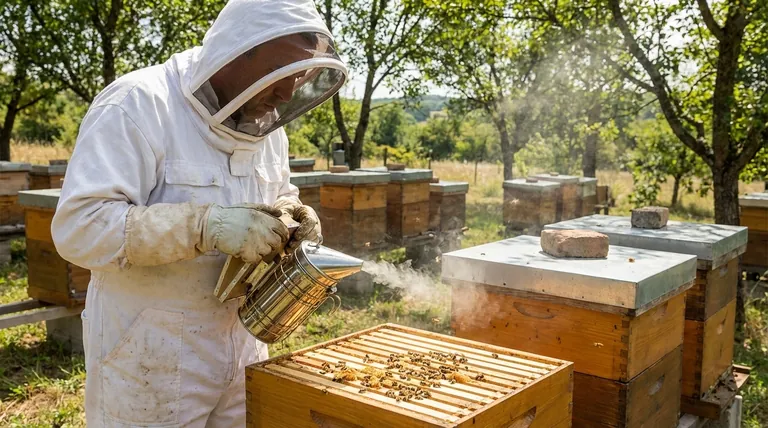For beekeepers, the gentle application of smoke is a fundamental technique for safely managing a hive during inspections or honey harvesting. It works by interrupting the bees' primary modes of communication and defense, making them significantly more docile and less likely to sting. This ensures a calmer, safer experience for both the beekeeper and the colony itself.
Smoke does not sedate or harm the bees. Instead, it cleverly triggers their natural survival instincts, masking their alarm signals and redirecting their focus from defense to self-preservation.

How Smoke Influences Bee Behavior
Understanding the two primary effects of smoke is key to appreciating its role in beekeeping. It is a tool that works with the bees' biology, not against it.
Masking the Alarm Pheromone
When a guard bee perceives a threat or stings an intruder, it releases an alarm pheromone. This chemical signal instantly alerts the rest of the colony, essentially shouting "Attack!"
Smoke, composed of thousands of tiny particles, effectively scrambles this signal. It overwhelms the bees' sensitive antennae, making it impossible for them to detect the alarm pheromone. This prevents a single defensive action from escalating into a full-blown colony attack.
Triggering a Feeding Response
Bees associate smoke with a potential forest fire, a catastrophic threat to their home. Their ingrained survival instinct tells them to prepare to abandon the hive.
To prepare for this journey, they immediately begin to engorge themselves on honey, stocking up on energy reserves. A bee with a full stomach finds it physically difficult to bend its abdomen into the "C" shape required to sting effectively. This makes them significantly more sluggish and less aggressive.
The Goal: A Calm and Safe Harvest
The use of smoke is not about the beekeeper's comfort alone; it is a critical practice for ensuring the health and stability of the entire colony.
Protecting the Beekeeper
The most immediate benefit is a dramatic reduction in stings. This makes the essential tasks of inspecting hive health and harvesting honey manageable and safe for the person managing the colony.
Protecting the Colony
When a honeybee stings a mammal, its barbed stinger becomes lodged in the skin. When the bee pulls away, the stinger and attached abdominal tissues are ripped from its body, causing the bee to die.
By using smoke to minimize aggression, a beekeeper drastically reduces bee mortality during an inspection. Preserving the lives of worker bees is essential for a thriving, productive colony.
Understanding the Trade-offs and Alternatives
While smoke is a standard tool, its application requires skill, and modern beekeeping offers alternative methods that reduce the need for it.
The Risk of Over-Smoking
Using too much smoke can be counterproductive. It can overly agitate the bees, drive them off the combs entirely, or even impart a smoky flavor to the honey. The goal is to use just a few gentle puffs to interrupt behavior, not to fill the hive with smoke.
Mechanical Bee Removal
Even with smoke, bees will remain on the honey frames. Beekeepers often use a soft bee brush to gently sweep the remaining bees off the comb before taking it for extraction. Some may also use a firm shake to dislodge most of the bees back into the hive.
Alternative Hive Designs
Some modern hive systems are designed specifically to minimize disturbance and the need for smoke.
The Flow Hive, for instance, allows honey to be drained directly from the frames via a tap without opening the main hive body. Similarly, Top Bar hives involve simply cutting a comb out for a "crush and strain" harvest, which can often be done with minimal disruption.
Making the Right Choice for Your Goal
Your approach to using smoke will depend on your equipment and beekeeping philosophy.
- If your primary focus is traditional beekeeping: Mastering the gentle and effective use of a smoker is a fundamental skill for safely managing standard Langstroth hives.
- If your primary focus is minimal disturbance: Consider investing in systems like the Flow Hive, which are specifically engineered to harvest honey without opening the hive.
- If your primary focus is simplicity and low cost: A Top Bar hive allows for a simple harvest by cutting out the comb, often reducing the need for extensive smoking and expensive extraction equipment.
Ultimately, understanding the bees' response to smoke allows you to work with their nature, not against it, for a more successful and sustainable harvest.
Summary Table:
| Effect of Smoke | Key Benefit |
|---|---|
| Masks Alarm Pheromone | Prevents defensive colony-wide attack |
| Triggers Feeding Response | Makes bees docile and less likely to sting |
| Reduces Bee Mortality | Protects the health of your colony |
| Ensures Beekeeper Safety | Allows for calm inspections and harvesting |
Ready for a safer, more productive harvest? As HONESTBEE, we supply commercial apiaries and beekeeping equipment distributors with the high-quality, wholesale-focused supplies needed to manage hives effectively—from reliable smokers to protective gear. Let us help you work with your bees' nature for a more successful operation. Contact our team today to discuss your needs!
Visual Guide

Related Products
- Stainless Steel Honey Bee Smoker Hive and Honeycomb Smoker for Beekeeping
- Economy Galvanized Beekeeping Honey Bee Smoker for Wholesale
- European Stainless Steel Bee Smoker for Honey Bee Hive
- Premium Traditional Copper Bee Smoker with Bellows
- Professional Bee Smoker with Elongated Spout and Durable Bellows for Beekeeping
People Also Ask
- What is the purpose of a bee smoker and how should it be used? A Guide to Calm, Safe Hive Inspections
- What is a bee smoker and how does it work? Master the Tool for Calm, Safe Hive Inspections
- What happens to bees when they sense smoke? Unlock the Secret to Calm Hive Inspections
- How long does it take to clean a bee smoker? From 15-Minute Quick Fix to 10-Hour Deep Clean
- What is a bee smoker and what is its primary purpose? Master Safe Hive Inspections



















